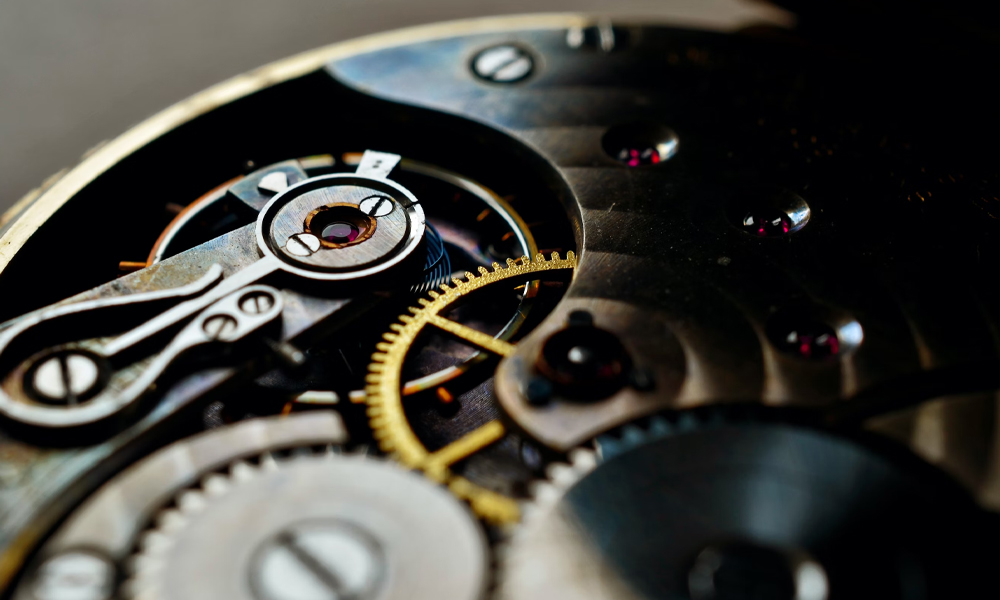One of the most crucial factors to consider when buying a watch is the movement. A watch’s movement refers to the mechanism that powers it and keeps it ticking. There are three main types of movements: quartz, mechanical, and automatic. Each has its advantages and disadvantages, and a handful top-selling brands.
Understanding Watch Movements
Watch movements are the powerhouse of timepieces, determining their function and inner mechanisms. They come in various types, such as mechanical, automatic, and quartz, each with distinct characteristics. Mechanical movements feature a series of gears and are popular among luxury brands like Patek Philippe. On the other hand, quartz movements utilize an electrical circuit and are commonly found in pocket watches and wristwatches. Understanding these different types enhances one’s appreciation for the artistry of watchmaking.
Comparing watch movements
Mechanical vs Quartz
While mechanical movements are valued for their craftsmanship and artistry, quartz movements are prized for their precision and battery life. A mechanical watch’s mainspring stores energy, while a quartz watch uses electrical charge to vibrate a quartz crystal at a precise frequency. Quartz watches are often more affordable, whereas mechanical watches are considered luxury timepieces that require regular upkeep, unlike quartz watches with minimal maintenance needs.
Mechanical vs Automatic
Mechanical watches, whether manual or automatic, exude traditional craftsmanship through their intricate gear train and balance wheel. In contrast, automatic timepieces boast oscillating weights and rotors, showcasing a different type of movement. While mechanical watches are prized for their sweeping second hands and historic connection to watchmaking, automatic watches are celebrated for their kinetic energy efficiency and convenient self-winding capabilities. Both types represent the ingenuity of watchmakers throughout history.
Quartz vs Automatic
Automatic and quartz movements differ in their power sources. While automatic or self-winding watches harness kinetic energy, quartz movements rely on the oscillations of a quartz crystal. Automatic watches offer long-term cost-efficiency by eliminating the need for battery replacements, while quartz watches are known for precise timekeeping. The rotor and balance wheel of automatic watches represents traditional craftsmanship, contrasting with the electrical charge used in quartz movements.
Understanding Quartz Watch Movements
Quartz movements, powered by a battery and a tiny vibrating quartz crystal, provide accurate timekeeping with low maintenance. They are more affordable than mechanical movements, featuring a smooth, ticking second hand. High-end quartz watches, like Seiko, utilize advanced technology for exceptional precision. This type is accessible to a wider consumer base, making it a popular choice in the watch market. Its precise operation and affordability contribute to its widespread popularity.
How Quartz Movements Operate: Quartz movements operate using a battery to send an electrical current through a small quartz crystal, causing it to vibrate at a specific frequency. These vibrations are measured and converted into precise timekeeping movements, known for their accuracy and low maintenance requirements, commonly found in many affordable timepieces. Quartz movements are favored for their reliability and are widely used in the watch market. While most often used in the most affordable timepieces, technology like using light as a recharging power source is found in some higher-end quartz watches.
Advantages and disadvantages of Quartz watches: While quartz watches use battery-powered quartz crystal for accuracy and low maintenance, they may lack the craftsmanship of mechanical watches. Despite being less expensive, some watch enthusiasts prefer traditional mechanical movements for their artistry and value retention. High-end mechanical watches often hold their value better than their quartz counterparts.
Citizen Eco-Drive Promaster GMT
The Citizen Eco-Drive Promaster GMT is a solar-powered watch that is perfect for adventurers and travelers. It features a durable stainless steel case and bracelet, an anti-reflective sapphire crystal, and water resistance up to 200 meters. The watch also has a dual time display, so you can keep track of the time in two different time zones. The Eco-Drive technology means that the watch is recharged by any light source, so you never have to worry about replacing batteries.
Citizen Eco-Drive Promaster GMT key features:
- Eco-Drive technology: Powered by any light source, so you never have to replace batteries
- Stainless steel case and bracelet: Durable and comfortable to wear
- Anti-reflective sapphire crystal: Scratch-resistant and clear
- Water resistance up to 200 meters: Perfect for swimming, diving, and other water activities
- Dual time display: Keep track of the time in two different time zones
- Luminous hands and markers: Easy to see in low-light conditions
- Rotating bezel: Track elapsed time
- Date display
Seiko Prospex Solar Diver’s Watch
The Seiko Prospex Solar Diver’s Watch is a stylish and functional timepiece that’s perfect for both professional and recreational divers. It’s recharged with any light source and never needs a battery change. The watch is also water resistant up to 200 meters.
Seiko Prospex Solar Diver’s Watch key features:
- Eco-Drive technology: Powered by any light source, so you never have to replace batteries
- Stainless steel case and bracelet: Durable and comfortable to wear
- Hardlex crystal: Scratch-resistant
- Water resistance up to 200 meters: Perfect for swimming, diving, and other water activities
- Unidirectional rotating bezel with elapsed time markings
- Luminous hands and markers: Easy to see in low-light conditions
- Date display
- Silicone strap
Mechanical movement
Mechanical movements, whether manual or automatic, capture the essence of precision craftsmanship and historical significance in watchmaking. The seamless integration of mechanical parts in automatic movements showcases the evolution of timekeeping artistry. Harnessing the kinetic energy of the spring drive, these movements deliver a captivating timekeeping experience. Enthusiasts who appreciate the art of watchmaking are drawn to the intricate gears and mechanical parts of different types of movements, resonating with luxury brands and Swiss watchmakers.
Strengths and weaknesses of mechanical watches: Mechanical watches, marvels of miniaturized engineering, boast undeniable strengths: unmatched craftsmanship, heirloom-worthy durability, and a distinct personality. They ditch pesky batteries for self-winding, are immune to obsolescence, and can even accrue value. However, their weaknesses whisper a different tune. Accuracy is a touch wonky, regular maintenance a must, and roughhousing a big no-no. They’re also bulky and often limited to basic timekeeping. So, the choice boils down to this: embrace the charm of intricate mechanics and timeless elegance, or prioritize convenience and pixel-perfect precision?
Rolex Oyster Perpetual
The Oyster Perpetual is a Rolex timepiece that transcends mere watchmaking. It’s an icon, a legend, a symbol of timeless style and unyielding precision. Born in 1926 from the mind of Rolex founder Hans Wilsdorf, the Oyster Perpetual was the world’s first waterproof wristwatch, forever altering the landscape of horology. Its deceptively simple design—a round case, three hands, and a clean dial—belies its revolutionary spirit. The Oyster Perpetual isn’t about ostentatious flourishes or fleeting trends. It’s about the purity of form and function, the quiet confidence of knowing you possess a piece of history.
Over the years, the Oyster Perpetual has evolved, offering a spectrum of sizes, materials, and dials to suit any wrist and personality. Yet, its core essence remains unchanged. It’s a watch for every occasion, from boardroom meetings to mountain summits, a constant companion that whispers tales of adventure, accomplishment, and unwavering reliability.
Rolex Oyster Perpetual key features:
- Movement: Perpetual Calibre 3230, a self-winding mechanical movement with a 70-hour power reserve. It is COSC-certified, which means it meets the Swiss Chronometer Official Control Institute’s standards for accuracy and precision.
- Dial: Available in a variety of colors, including black, white, blue, green, and yellow. Some dials have Roman numeral hour markers, while others have baton hour markers.
- Oyster bracelet, made of Oystersteel
- Water resistance up to 100 meters.
Automatic movement
Automatic movements, also known as self-winding movements, operate on the principle of kinetic energy. This energy is generated through the motion of the wearer’s arm, which winds the mainspring and powers the watch. Watch enthusiasts favor automatic movements for their traditional craftsmanship and the intricate series of gears that make these movements unique. Popular luxury brands like Patek Philippe and Grand Seiko are revered for their exquisite automatic movements, reflecting a blend of artistry and innovation in the watch market.
Advantages and disadvantages of automatic watches: Automatic watches offer the convenience of self-winding, eliminating the need for manual winding or battery replacement. Often associated with prestige and luxury, they feature intricate mechanical craftsmanship. However, these benefits come at a cost, as automatic watches tend to be more expensive and require periodic maintenance. While not as accurate as quartz watches, the charm of automatic movements lies in their mechanical complexity. Finding the right balance between charm and practicality is key when considering automatic watches.
TAG Heuer Formula 1
Buckle up for a thrill ride with the TAG Heuer Formula 1, a watch that bleeds speed and precision like a race car. Forget the stuffy boardroom elegance of its pricier counterparts; this timepiece is built for the adrenaline-fueled corners of life. Imagine a sleek, stainless steel chassis, aerodynamically designed to hug your wrist like a spoiler. The tachymeter bezel, once used by pit crews to calculate a driver’s lap speed, now pulsates with possibility, whispering tales of checkered flags and podium finishes. And those hands? They’re like the tachometer needle itself, darting across the dial with the focus of a champion.
But the TAG Heuer Formula 1 isn’t just about brawn; it’s got brains too. A quartz movement, the workhorse of the racing world, keeps you on split-second time, while the 200-meter water resistance lets you chase that checkered flag through rain or shine. And let’s not forget the interchangeable straps, a pit stop in your own style. Leather for the boardroom podium, rubber for the victory lap, the choice is yours.
TAG Heuer Formula 1 key features:
- Stainless steel, some models with ceramic bezel
- Diameter: 41mm or 43mm
- Thickness: 11.5mm to 12.4mm
- Water resistance up to 200 meters
- Crystal: Scratch-resistant sapphire crystal
- Bezel: Unidirectional bezel with tachymeter scale (except quartz models)
- Color: Various options available, including black, blue, white, and sunray
- Markers: Applied or printed hour markers with luminous fill
MTM Silver Hypertec H-61
The MTM Silver Hypertec H-61’s hidden gem lies in the dual-rotating bezels. One, a unidirectional warrior, tracks elapsed time for your daring dives or daring deadlines. The other, a two-way maestro, lets you juggle time zones with the ease of a seasoned traveler. And with 24-hour GMT and a date window nestled within, you’re never lost, only ever a twist away from wherever your adventure takes you.
Water? No problem. The H-61 laughs at 100 meters of it, thanks to its Swiss-made heart, the Ronda 505 movement. It’s a reliable companion, keeping perfect time even when you’re pushing your limits. And let’s not forget the options: swap the stainless steel bracelet for a tan nylon strap for a touch of summer cool, or keep it classic with black rubber for the urban explorer in you.
MTM Silver Hypertec H-61 key features:
- Material: Solid stainless steel, built for durability in any environment.
- 42mm diameter without crown
- 12.5mm thickness
- Water resistance up to 100 meters
- Scratch-resistant sapphire
- Dual-rotating
- Brass, adding a touch of warmth to the rugged design.









